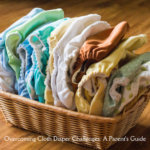In an era where sustainability is more than a buzzword, many parents are turning back to the tried-and-true method of using cloth diapers. However, the challenge often lies not just in choosing the right cloth diapers but also in mastering the art of hand washing them to ensure longevity and hygiene. This guide offers a comprehensive look at how to select and care for hand-washable cloth diapers, drawing on my personal experiences as a 40-year-old mother committed to using natural and gentle products for both my baby and my skincare routine.
Understanding Cloth Diapers
What Are Cloth Diapers? Cloth diapers are reusable diapers made from natural fibers, man-made materials, or a combination of both. Unlike disposable diapers, they require proper cleaning and maintenance to keep them functional and sanitary.
Types of Cloth Diapers Suitable for Hand Washing
- Flats and Prefolds: Simple, easy to clean, and quick to dry.
- Fitted Diapers: More absorbent but take longer to dry.
- All-in-Ones (AIOs): Convenient but require careful handling to clean thoroughly.
Benefits of Hand Washing Cloth Diapers
Environmental Impact
- Significantly reduces waste compared to disposables.
- Uses less water and energy than machine washing.
Cost-Effectiveness
- Extends the life of the diapers by avoiding the harshness of machine cycles.
- Saves on electricity and water bills.
Health and Safety
- Allows for the use of gentle, baby-friendly detergents.
- Reduces wear and tear, keeping diapers soft and gentle on baby’s skin.
Choosing the Right Diapers for Hand Washing
Material Considerations
- Natural Fibers: Cotton, bamboo, and hemp are ideal for their durability and ease of cleaning.
- Absorbency Needs: Select diapers with adequate absorbency to minimize changes and washing frequency.
Ease of Cleaning
- Diapers should be simple to rinse and not retain odors or stains.
- Opt for lighter colors or patterns that do not show stains easily.
Hand Wash Techniques for Cloth Diapers
Preparation
- Rinsing: Remove solids and rinse diapers in cold water immediately after use.
- Soaking: Soak diapers in a mild, eco-friendly detergent before washing to help lift stains.
Washing Process
- Scrubbing: Use a gentle brush or a clean hand to agitate the diapers in a washing basin.
- Water Temperature: Use warm water to better dissolve detergents and remove oils and residues.
Rinsing and Drying
- Rinse thoroughly in cold water to remove any soap residue.
- Hang diapers to dry in a well-ventilated area or outdoors for natural bleaching by the sun.
Best Practices for Maintaining Cloth Diapers
Regular Maintenance
- Sanitization: Occasionally boil diapers if they start retaining smells or after an illness.
- Stain Removal: Treat stains with baking soda or vinegar before washing for natural stain removal.
Storage
- Store diapers in a dry, airy space until ready to wash to prevent mold and mildew buildup.
- Use a lined diaper pail with a lid to contain odors and maintain hygiene.
Cost Analysis: Savings Over Time
Initial Investment vs. Ongoing Savings
- Start-Up Costs: Initial purchase of diapers, pails, liners, and washing supplies.
- Long-Term Savings: Calculation of savings over disposables for the diapering period of a child.
Table: Cost Comparison of Cloth vs. Disposable Diapers
| Item | Cloth Diapers | Disposable Diapers |
|---|---|---|
| Cost Over 2 Years | $500 | $1400 |
| Environmental Impact | Lower | Higher |
| Baby’s Health | Better | Variable |
Integrating Cloth Diapers into Your Routine
Choosing and maintaining hand-washed cloth diapers is not only a sustainable choice but also a loving one towards your baby and the environment. With the right techniques and a little practice, it becomes an easy part of your daily routine, offering not just savings but also a deep sense of fulfillment.
Drawing from my own experience in seeking out natural solutions for both my children and personal skincare, I’ve found that embracing such eco-friendly practices contributes positively to our family’s health and our planet’s well-being. Embracing hand-washed cloth diapers is a step towards a more sustainable lifestyle, one diaper change at a time.
For more detailed information on selecting and caring for hand-washed cloth diapers, visit our comprehensive guide.







